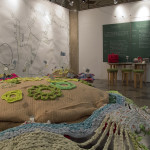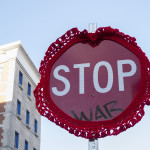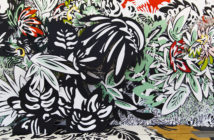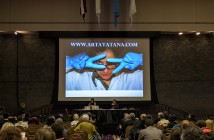Last December, I bought a book at JP Knit and Stitch called 'Hooked on Crochet.' I attribute this uncharacteristic move to pick up a craft to a former student of mine, Emma Lanctot, who made a gorgeously red, lacy wrap for a stop-sign as her first semester final (picture included). She assured me it was easy (and sculptural) and I'd get the hang of it in no time. It was probably her confident tone that helped me push through the aggravating first few days, to the point where I am now, totally hooked on crochet.
This somewhat lengthy and personal backstory serves to tell you why I went to BU's 808 Gallery last night. Jane D. Marsching and Andi Sutton, founders of the collective Plotform, were hosting a stitch night. I went because they are friends, but mostly because I wanted to interact with artists who crochet, sculpturally, and in their specific case, conceptually. And I took my mom along.
Stitching the Shore, the name of the event, was a public gathering in the context of System: ECOnomies, an exhibition of ambitious artistic projects that consider sustainability in theory and practice, mostly through very DIY approaches in small communities. Plotform's project Marsh Radio Island is a proposal. The installation presents a vast and imaginative solution for regenerating salt marshes around Boston's coastline. Buoyant crocheted forms called 'flotants', in reference to the flotant marshes of Louisiana, would be seeded with a variety of marshland plants, chosen for their capacity to absorb and filter toxins. As the plants grow and put down roots, they create a strong natural barrier again tidal surges.
At the stitch night only a little of this was discussed—crochet is a little finicky to learn in an hour for anyone—but those present did express their excitement about the project and the feeling of participating in the beginnings of a community-based form of craftivism, the now ubiquitous portemanteau word for creative forms of engagement.
Seeded within the torn sheets that I was using to make my piece of the flotant were little strips of paper with questions. They fell out from time to time as I unwound the ball.
Where do you get your news about your local community?
I asked my mother, who was sitting next to me struggling with a somewhat complex but lovely pattern. She lives in midcoast Maine. "The Free Press... Chet Knowles [the octogenarian neighbor who runs his own email-based equivalent of Craigslist]... my friends... public radio."
My answer was a slightly updated version—social media, the web, and radio primarily—but really when it comes down to it, I also rely on my local newspaper, the JP Gazette to know what my community's concerns are.
Have you swum off a salt marsh?
Not exactly, though I've swum in a lot of different kinds of salt and brackish water. My mother and I exchanged stories about silty mush oozing through toes and whether our love of swimming would be enough to overcome the queasy feeling of sinking into mud.
In spite of being hosted in a vast and echoey former Cadillac showroom, the atmosphere was intimate and congenial. A radio broadcast from Plotform's own pirate radio station WMIR (at 990 AM) filled the space around us with songs about water, bird sounds, poems and readings.
The questions and conversation grew lively at the end of the event, when crochet hooks were put down and Jane and Andi asked for reactions to the gathering. Unanimously, there was a hope for more. While most participants came primarily because of the invitation to learn crochet, they now discussed the possibilities in bringing these collective shore stitching nights to the shoreline communities they could benefit—a vast map of the Boston coastline highlights these neighborhoods each with a unique crochet pattern, Dorchester, Southie, Eastie, Quincy, etc.
As we got ready to leave, my mom was sharing her perspective with the artists: the ambitious project to work with the city's scientists, communities, and officials is not unlike the slow, painstaking and frustrating process of building a crochet pattern, one stitch at a time. I thought the analogy was pretty fitting. Jane made it clear that this approach is only a doorway. Following Sandy, Boston's vulnerability to rising sea-levels is on everyone's mind, and plans for the city's protection will have to developed and concretized soon. Let's hope the city gets hooked by Plotform's colorful and community based approach, and makes it a part of that plan.

My contribution to the flotants!
°°°
Upcoming events (talks, demos, pot-lucks) at 808 Gallery, held within the context of this show can be found here.
System: ECOnomies runs until March 30, 2013
808 Gallery at Boston University
808 Commonwealth Avenue, Boston, MA
System: ECOnomies presents the work of individual artists and collaboratives who consider the themes of sustainability—environmental, cultural, or economic—through the invention or investigation of ecological systems or micro-communities. The exhibition examines the feasibility of sustainable solutions on small scales and the value of working within modest and minimal means.
Participating artists: Kim Beck, Center for PostNatural History, Amy Franceschini, Mary Mattingly, Jaimes Mayhew, Maria Molteni/Colette Aliman, Plotform, and Marina Zurkow.
- Marsh Radio Island installation by Plotform photo: Stephanie Cardon
- Emma Lanctot, MassArt Freshman, Crocheter photo: Stephanie Cardon
- Stitching the Shore, together photo: Stephanie Cardon







